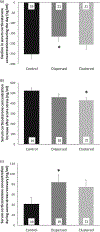Timing matters: the interval between acute stressors within chronic mild stress modifies behavioral and physiologic stress responses in male rats
- PMID: 29648498
- PMCID: PMC6562168
- DOI: 10.1080/10253890.2018.1459557
Timing matters: the interval between acute stressors within chronic mild stress modifies behavioral and physiologic stress responses in male rats
Abstract
Chronic mild stress can lead to negative health outcomes. Frequency, duration, and intensity of acute stressors can affect health-related processes. We tested whether the temporal pattern of daily acute stressors (clustered or dispersed across the day) affects depression-related physiology. We used a rodent model to keep stressor frequency, duration, and intensity constant, and experimentally manipulated the temporal pattern of acute stressors delivered during the active phase of the day. Adult male Sprague-Dawley rats were exposed to one of three chronic mild stress groups: Clustered: stressors that occurred within 1 hour of each other (n = 21), Dispersed: stressors that were spread out across the active phase (n = 21), and Control: no stressors presented (n = 21). Acute mild stressors included noise, strobe lights, novel cage, cage tilt, wet bedding, and water immersion. Depression-related outcomes included: sucrose preference, body weight, circulating glucocorticoid (corticosterone) concentration after a novel acute stressor and during basal morning and evening times, and endotoxin-induced circulating interleukin-6 concentrations. Compared to control rats, those in the Clustered group gained less weight, consumed less sucrose, had a blunted acute corticosterone response, and an accentuated acute interleukin-6 response. Rats in the Dispersed group had an attenuated corticosterone decline during the active period and after an acute stressor compared to the Control group. During a chronic mild stress experience, the temporal distribution of daily acute stressors affected health-related physiologic processes. Regular exposure to daily stressors in rapid succession may predict more depression-related symptoms, whereas exposure to stressors dispersed throughout the day may predict diminished glucocorticoid negative feedback.
Keywords: Acute pro-inflammatory response; acute stressor dynamics; chronic mild stress; circulating glucocorticoid dynamics; depressive behavior; temporal pattern.
Conflict of interest statement
Disclosure statement
No potential conflict of interest was reported by the authors.
Figures





Similar articles
-
Sympathetic nervous system contributes to enhanced corticosterone levels following chronic stress.Psychoneuroendocrinology. 2016 Jun;68:163-70. doi: 10.1016/j.psyneuen.2016.02.027. Epub 2016 Feb 26. Psychoneuroendocrinology. 2016. PMID: 26974501 Free PMC article.
-
Body weight gain and diurnal differences of corticosterone changes in response to acute and chronic stress in rats.Psychoneuroendocrinology. 2003 Feb;28(2):207-27. doi: 10.1016/s0306-4530(02)00017-3. Psychoneuroendocrinology. 2003. PMID: 12510013
-
Psychological stressors as a model of maternal adversity: diurnal modulation of corticosterone responses and changes in maternal behavior.Horm Behav. 2007 Jan;51(1):77-88. doi: 10.1016/j.yhbeh.2006.08.008. Epub 2006 Oct 10. Horm Behav. 2007. PMID: 17034794
-
Analytic and Interpretational Pitfalls to Measuring Fecal Corticosterone Metabolites in Laboratory Rats and Mice.Comp Med. 2019 Oct 1;69(5):337-349. doi: 10.30802/AALAS-CM-18-000119. Epub 2019 Oct 2. Comp Med. 2019. PMID: 31578162 Free PMC article. Review.
-
The temporal dynamics of the stress response.Neurosci Biobehav Rev. 1997 Nov;21(6):775-82. doi: 10.1016/s0149-7634(96)00057-7. Neurosci Biobehav Rev. 1997. PMID: 9415902 Review.
Cited by
-
Chronic Unpredictable Mild Stress Model of Depression: Possible Sources of Poor Reproducibility and Latent Variables.Biology (Basel). 2022 Nov 6;11(11):1621. doi: 10.3390/biology11111621. Biology (Basel). 2022. PMID: 36358321 Free PMC article. Review.
-
Anti-oxidant and anti-apoptotic effects of gamma-oryzanol on male reproductive function in chronic restraint stress in rats.Avicenna J Phytomed. 2025 Jan-Feb;15(1):890-906. doi: 10.22038/AJP.2024.24819. Avicenna J Phytomed. 2025. PMID: 40271500 Free PMC article.
-
Expression alteration of microRNAs in Nucleus Accumbens is associated with chronic stress and antidepressant treatment in rats.BMC Med Inform Decis Mak. 2019 Dec 19;19(Suppl 6):271. doi: 10.1186/s12911-019-0964-z. BMC Med Inform Decis Mak. 2019. PMID: 31856805 Free PMC article.
-
Testicular histopathology in rats co-exposed to heat and psychological stressors.Heliyon. 2023 Feb 28;9(3):e14146. doi: 10.1016/j.heliyon.2023.e14146. eCollection 2023 Mar. Heliyon. 2023. PMID: 36915529 Free PMC article.
-
Persistent muscle hyperalgesia after adolescent stress is exacerbated by a mild-nociceptive input in adulthood and is associated with microglia activation.Sci Rep. 2022 Oct 31;12(1):18324. doi: 10.1038/s41598-022-21808-x. Sci Rep. 2022. PMID: 36316425 Free PMC article.
References
Publication types
MeSH terms
Substances
Grants and funding
LinkOut - more resources
Full Text Sources
Other Literature Sources
Medical
